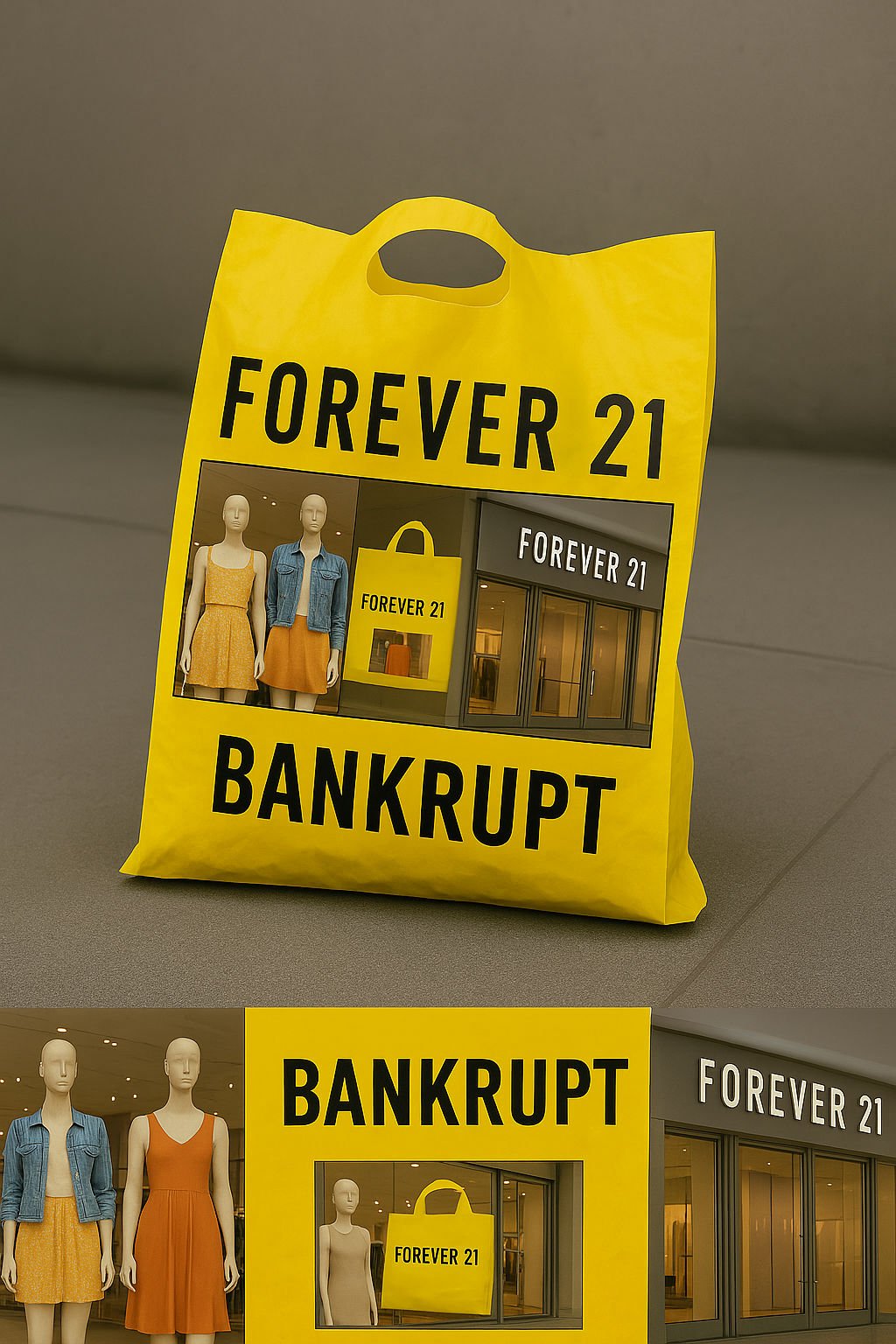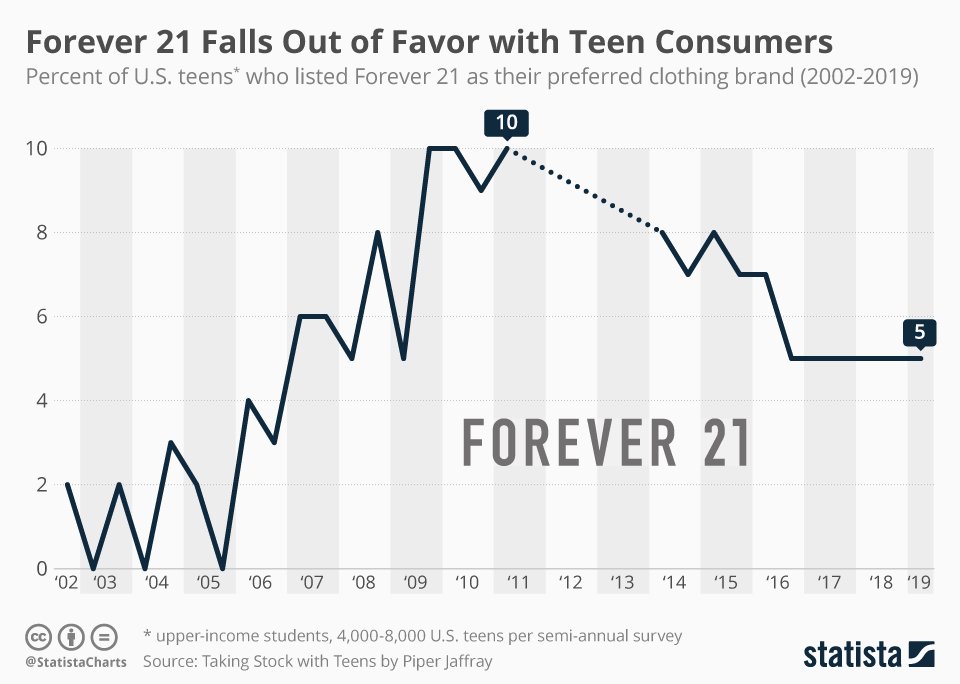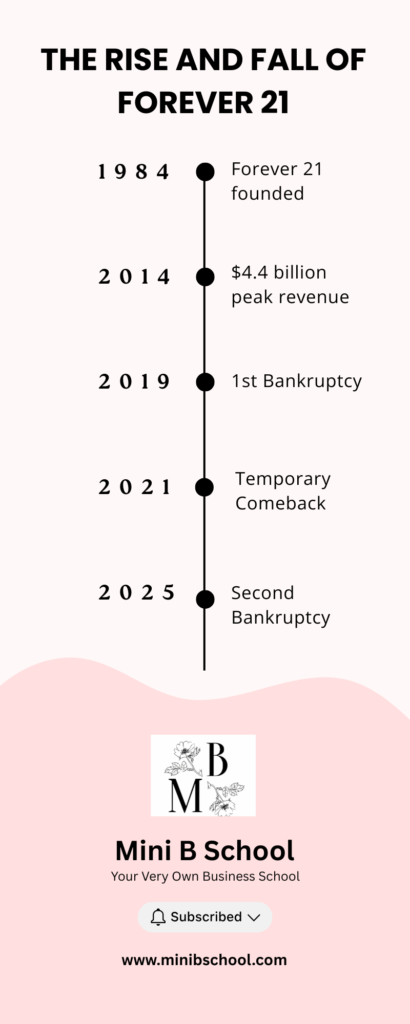Forever 21 was one of the greatest go-to fast fashion brands, with over 800 stores and $4.4 billion in revenue. However, it is now on the verge of liquidation in the U.S. after filing for bankruptcy not once but twice!

So, how did this retail giant go from being an industry leader to a financial disaster? Let’s break it down.
The Rise of Forever 21
Humble Beginnings
In 1984, Jin Sook and Do Won Chang, a Korean immigrant couple, opened their first store, Fashion 21, in Los Angeles with just $11,000 in savings.
Unlike established, pricey brands like Gap, Abercrombie, or Aeropostale, the brand brought designer-inspired fashion to the masses at an affordable price. Their strategy focused on:
- Fast production of trendy clothing, keeping manufacturing costs low.
- Affordable pricing for young consumers.
- Constantly updated styles to keep up with fashion trends.
This approach worked. The company expanded rapidly, opening new stores every six months, and by 2014, it was generating $4.4 billion in sales globally.
At its peak, 10% of U.S. teens called Forever 21 their favorite brand. The company seemed unstoppable, but retail success is never predictable.

The First Bankruptcy (2019): Expansion Gone Wrong
Overexpansion and Retail Missteps
When one stream gains traction, the logical move is to expand there first, but Forever 21 took the wrong approach! As online shopping gained momentum, it doubled down on physical retail instead of adapting to e-commerce.
They focused on large-format stores, some over 90,000 square feet, and high-rent locations in shopping malls. Forever 21’s USP was affordability, but such an expensive expansion could not complement its budget-conscious strategy.
Also, the company started expanding into international markets without strong demand.
When consumers realized Forever 21 was no longer affordable, they shifted to other brands. What was once a strength became a financial burden for this American retailer.
By 2018-2019, their stores in Canada, Europe, and Asia were losing $10 million per year, while mall traffic was declining.
With fewer shoppers visiting stores and online competitors rising, Forever 21 filed for bankruptcy in 2019, closing 350 stores worldwide. But this wasn’t the end…
The Buyout and Temporary Comeback
Rescue by Investors
A consortium of investors, including Authentic Brands Group, stepped in and bought Forever 21 out of bankruptcy. They focused on:
- Closing underperforming stores
- Cutting costs to improve profitability
- Injecting fresh capital to keep the brand alive
By 2021, things appeared to be stabilizing. Forever 21 generated $2 billion in revenue. However, a deeper problem remained. Forever 21 was still struggling to stay relevant in a rapidly evolving retail landscape.
Investor’s Regret
One of the investors, Jamie Salter, CEO of Authentic Brands Group, later admitted, “Buying Forever 21 was the biggest mistake I ever made.”
The reason? Two massive challenges:
- The rise of ultra-fast fashion giants like Shein & Temu.
- Forever 21’s failure to evolve with digital-first shopping trends.

The Second Bankruptcy (2025): Shein, Temu & The De Minimis Exemption
The Rise of Shein & Temu
While Forever 21 tried to recover, Shein and Temu changed the game. These Chinese e-commerce giants offered trendy fashion at even lower prices, and they had a secret weapon called the ‘De Minimis Exemption’.
The De Minimis Exemption
This U.S. trade loophole, in place since 1938, allowed products under $800 to be shipped into the U.S. tax-free, giving Shein and Temu a massive price advantage over brands like Forever 21.
To put this in perspective, a Forever 21 t-shirt? $11. A similar one on Shein? $5! That’s a huge price difference from a consumer’s perspective!
By avoiding import duties and tariffs, Shein and Temu flooded the U.S. market with cheaper, trendier fashion, making it nearly impossible for traditional retailers like Forever 21 to compete.

Forever 21 even partnered with Shein in 2023, hoping to leverage its e-commerce reach. But the damage had already been done. Over the last three years, Forever 21 lost $400 million; another $180 million is expected in 2025.
What’s Next for Forever 21?
Forever 21 is now liquidating in the U.S., but its international stores and website will likely continue to operate. The company also listed its products on Amazon’s Haul to get traction.
The Closing of the De Minimis Exemption
In a major policy shift, Donald Trump has announced plans to close the de minimis exemption.
Shein and Temu might lose their tax-free advantage, forcing them to increase prices. Will this help American retailers bounce back? Or is it too late? What are your thoughts on this? Let us know in the comments.
How the closure of De Minimis can impact Amazon? Read our SWOT Analysis of Amazon to know.
FAQs
In 2019, Forever 21 filed for Chapter 11 bankruptcy due to overexpansion, declining mall traffic, and increased competition from online retailers. The company closed numerous stores and restructured its operations to focus on profitability.
The second bankruptcy in 2025 was attributed to rising operational costs, stiff competition from online retailers like Shein and Temu, and an unsustainable business model. The company announced the closure of all 354 remaining U.S. stores by May 1, 2025.
Forever 21’s reliance on large physical store spaces became a liability as consumer preferences shifted toward online shopping. Additionally, the brand struggled to keep up with the rapid pace and low prices of emerging online competitors.
Forever 21’s fall highlights the dangers of rapid overexpansion without adapting to market changes. Retailers must balance growth with sustainability and remain agile in response to evolving consumer behaviors.
The shift toward online shopping and demand for sustainable fashion options reduced foot traffic to physical stores. Forever 21’s failure to adapt to these trends contributed to its declining sales.
The emergence of online fast-fashion retailers offering trendy clothing at lower prices intensified competition. Forever 21 struggled to match the speed and cost-efficiency of these digital-native brands.
While its U.S. retail presence has ended, Forever 21’s brand still holds value internationally. With strategic management and adaptation to current market trends, there’s potential for a resurgence in select markets.
Share this article on your socials.
